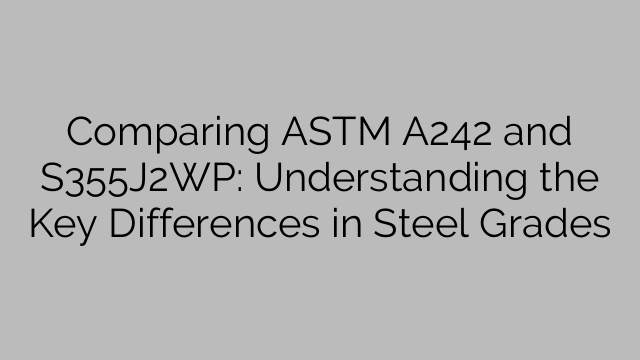ASTM A242 and S355J2WP are both high-strength low-alloy (HSLA) steels commonly used in the construction industry. While they have certain similarities, it is vital to understand the key differences between the two grades to make an informed decision about which one to choose for your specific application.
1. Chemical Composition:
ASTM A242: This grade of steel contains copper, chromium, manganese, and nickel as major alloying elements. The addition of copper provides enhanced corrosion resistance, making it suitable for outdoor applications.
S355J2WP: In contrast, S355J2WP contains higher concentrations of chromium and nickel, while providing a lower amount of copper. The higher chromium and nickel content contribute to improved overall corrosion resistance in various environments.
2. Corrosion Resistance:
Both ASTM A242 and S355J2WP are renowned for their excellent resistance to atmospheric corrosion. However, the varying alloying elements give them differing levels of protection against corrosion. While ASTM A242 offers good resistance to corrosion, S355J2WP is known for its exceptional resistance to harsh environments and marine atmospheres. Thus, if your project requires exposure to severe conditions, S355J2WP may be a more suitable choice.
3. Mechanical Properties:
ASTM A242: This grade of steel possesses a minimum yield strength of 50 ksi (345 MPa) and a minimum tensile strength of 70 ksi (483 MPa). It exhibits high tensile strength and excellent weldability.
S355J2WP: With a minimum yield strength of 355 N/mm², S355J2WP offers comparable tensile strength to ASTM A242. It also boasts excellent weldability and formability, making it a versatile choice for various structural applications.
4. Formability and Machinability:
Both ASTM A242 and S355J2WP exhibit good formability, allowing for the fabrication of complex shapes without compromising structural integrity. Additionally, these grades offer excellent machinability, enabling ease of cutting, drilling, and welding.
5. 응용 프로그램:
ASTM A242: This grade is widely used in structural applications, including buildings, bridges, freight cars, and transmission towers. Its corrosion resistance makes it an ideal choice for outdoor structures exposed to harsh atmospheric conditions.
S355J2WP: This grade is particularly suitable for applications where exposure to aggressive environments, such as marine atmospheres or industrial areas, is expected. It is commonly employed in the construction of coastal buildings, containers, and offshore structures.
In conclusion, both ASTM A242 and S355J2WP offer high-strength and corrosion-resistant properties suitable for various structural applications. The choice between the two grades depends on the specific environmental conditions and requirements of your project. While ASTM A242 provides good corrosion resistance, S355J2WP excels in harsh environments and marine atmospheres. Understanding the differences in chemical composition, corrosion resistance, mechanical properties, formability, and machinability will enable you to make an informed decision and select the most appropriate steel grade for your project.

